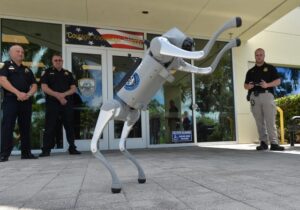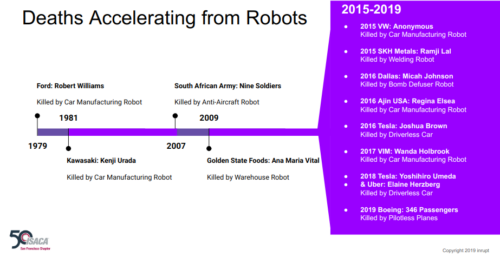It’s hard not to watch this repeatedly
Bonus points if you refuse to see the white cowboy hat.
In related news:

It’s hard not to watch this repeatedly
Bonus points if you refuse to see the white cowboy hat.
In related news:

Thirteen Years of Warning Signs: Iraq War Veterans and America’s Mental Health Crisis

On September 28, 2025, Thomas Jacob Sanford drove his pickup truck through the front doors of a Mormon church in Grand Blanc, Michigan. He opened fire on hundreds of Sunday worshippers with an assault rifle, planted improvised explosive devices, then doused the building with gasoline and burned it to the ground. Four people died. Eight were wounded.
The day before, Nigel Edge approached a North Carolina waterfront bar by boat and opened fire with a suppressed AR-style rifle. Three dead. Eight wounded.
Both men were 40 years old. Both were Marines who served in Iraq during the mid-2000s surge and sectarian violence.
This should not be treated as a coincidence, given a thirteen-year pattern anyone can plainly see.
A Pattern Demanding Somebody Care
Since 2012, at least nine Iraq War veterans have committed mass shootings in the United States, killing 24 people and wounding dozens more. The locations vary—churches, bars, airports, military bases—but the warning signs remain hauntingly consistent:
Benjamin Barnes (2012): Sent “I want to die” texts before killing a park ranger. Ex-girlfriend had documented his PTSD, weapons arsenal, and suicide threats in custody court papers. No intervention came.
Ivan Lopez (2014): Being evaluated for PTSD at Fort Hood when he killed three soldiers after an argument over leave paperwork. He was taking Ambien and antidepressants. His mother had died five months earlier. He had $14,000 in debt.
Esteban Santiago (2017): Walked into an FBI office claiming the CIA was controlling his mind, was held for psychiatric evaluation, then released. Two months later, he killed five people at Fort Lauderdale airport. His family had begged for help.
Bryan Riley (2021): Under the influence of methamphetamine and divine delusions, he murdered a family of four including a 3-month-old baby. His girlfriend knew he had PTSD. He believed God told him to save someone who didn’t exist.
Matthew Livelsberger (2025): Detonated a truck bomb outside a Trump building in Las Vegas on New Year’s Day to “relieve myself of the burden of the lives I took”. He had PTSD, depression, and multiple traumatic brain injuries. He was in the Army’s mental health program. He’d had three counseling sessions in the five months before his attack—then stopped seeking help because of Special Forces stigma.
Michael Brown (2025): Killed four people in a Montana bar next door to where he lived. His family had warned authorities a “snap could happen.” The VA allegedly told him he “no longer qualified for assistance.” Montana State Hospital refused admission unless court-ordered. He refused his schizophrenia medications.
And now Sanford and Edge, within 24 hours of each other.
Ideology Serves as a Distraction
The early reporting tried to frame Sanford’s attack as anti-Mormon extremism, with the President even calling it anti-Christian. Investigators suggested “possible anti-Mormon rhetoric.” The narrative was ready: religious hatred, domestic terrorism, the usual script was rolling immediately. But that’s NOT what the evidence so far really shows. Sanford drove past several other churches on the way to target the one he had no documented connection with.
What he did have was a ten-year-old son born with a severe medical condition requiring multiple surgeries, lengthy hospitalizations, and experimental treatment. The financial strain was crushing enough that he’d started a GoFundMe in 2015. He’d taken leave from his job as a Coca-Cola truck driver just to care for his child.
Edge had sued the VA just four days before his attack, alleging they conspired to block his treatment. He’d filed multiple frivolous lawsuits fed by social media memes, claiming his parents were “LGBTQ White Supremacist Pedophiles.” His ex-wife hadn’t heard from him in a decade. He’d legally changed his name. He was drowning in documented mental health crises his family couldn’t stop.
These weren’t ideological attacks. These were men in crisis—financial, medical, psychological—who had been failed by every system meant to care about them.
An Invisible Damaged Generation
Sanford and Edge represent a specific cohort: the Iraq War veteran generation, now entering middle age.
They enlisted young, served in Fallujah, Ramadi, Baghdad during the height of urban combat and IEDs. They came home to a country that had moved on, to a VA system that was overwhelmed, to civilian jobs that didn’t exist or didn’t pay enough.
Now they’re 40. The adrenaline has worn off. The coping mechanisms that worked at 25 don’t work anymore. Marriages fail. Parents die. Kids get sick. Medical bills pile up.
And the mental health system that was supposed to be there? It disappeared.
America’s Failed Basic Duty of Care
After sending its citizens into harm’s way, America ignored the basic health care they required. A ProPublica investigation found that half of routine VA inspections revealed mental health care failures—botched suicide screenings, failure to follow up with at-risk veterans, wait times stretching for months. Sixteen veterans who received substandard VA care have killed themselves or others since 2020.
Over three-quarters of the VA’s 139 networks report “severe” shortages of psychiatrists and psychologists. Rural veterans—who comprise 27% of those with serious mental illness—use intensive mental health programs at rates 58% lower than urban veterans. The further an American lives from urban areas, the higher the dangers.
The pattern is clear of veterans who seek help, show warning signs, even directly alert authorities, and then get no understanding or care. FBI evaluations release dangerous individuals after days. VA offices deny help even with diagnosed schizophrenics. Families file explicit warnings only to be told nothing can be done without court orders. Mental health programs abandoned due to systemic military and cultural stigma. Every case above represents a missed intervention point for public safety and healthcare, a system-wide failure, a preventable tragedy.
Every single one showed very obvious warning signs and American “safety” experts closed their eyes. Every single one fell through gaps in the system.
When Combat Trauma Meets Middle Age
Research on Iraq War veterans reveals the kind of simple truths most Americans still don’t seem to want to recognize:
They have 3-4 times higher violence rates than the general population—but that still means 91% never engage in severe violence. The 9% who do share specific risk factors: combat exposure during the surge or sectarian violence periods, traumatic brain injury from IED blasts, PTSD or moral injury, major life stressors, social isolation, and inadequate mental health treatment.
Combat trauma doesn’t fade—it compounds. PTSD symptoms often worsen in middle age as veterans lose the energy to suppress them. The hypervigilance that kept them alive in Fallujah becomes exhausting in suburbia.
Add civilian stresses: Sanford’s son with catastrophic medical needs. Lopez’s mother dying and $14,000 in debt. Santiago with $5-10 in his bank account. Livelsberger’s wife leaving after infidelity disputes. Barnes in a custody battle with restraining orders.
The “perfect storm” of mass murder symptoms emerges: unresolved trauma + life crisis + failed mental health system + military firearm access = catastrophe.
That should terrify everyone living in the neighborhoods where thousands more just like them are struggling in hidden pain while arming themselves for sudden action.
What Other Countries Do Differently
UK Iraq veterans show similar PTSD rates to Americans—9.4% compared to our estimated 11-20%. But they rarely commit mass shootings.
Why?
Basic gun control means mental health crises don’t escalate to mass casualties. Australia’s comprehensive mental health approach achieves better outcomes despite 22% of defense personnel experiencing mental health problems. Canada emphasizes immediate care access without bureaucratic barriers.
The US has 1.2 guns per person. Australia has 0.13. When mental health crises occur, gun availability determines lethality.
We could have both—the Second Amendment and proper mental health care.
We’ve chosen neither.
This isn’t complicated. Research identifies clear protective factors that reduce violence risk by 76-92% even among high-risk veterans: stable employment, meeting basic needs, social support, comprehensive mental health care, and temporary firearm restrictions during acute crises.
Critical intervention points include:
The transition period: First 3-5 years post-deployment require mandatory mental health screening and follow-up. Each year of delayed PTSD treatment increases symptom persistence by 5%.
Major life stressors: Divorce, death, financial crisis, medical emergencies—these trigger violence regardless of time since service. Brown’s mother died in 2021, twenty years after his Iraq deployment. Sanford served 2007-2008; his attack came seventeen years later.
Crisis presentations: When veterans show up at FBI offices claiming mind control, when families file warnings, when lawsuits get filed against the VA days before attacks—these demand immediate, aggressive intervention.
Comprehensive care: Mental health can’t be separated from financial stress, employment problems, and social isolation. Integrated support addressing all factors works. Fractured, bureaucratic systems fail.
The cost of doing this? Billions annually. The cost of not doing this? We’ve seen it nine times since 2012. We saw it twice in one weekend in September 2025.
We’ll see it again until mental health is prioritized for warriors.
The Human Cost
Twenty-four people are dead across these nine incidents. Dozens more wounded. Families destroyed. Communities traumatized. And nine veterans—who might have been saved with proper care—are dead or facing life in prison.
Everyone lost.
We can’t call these incidents random or ideological.
We can’t frame them as isolated acts of evil. We can’t focus on gun control or security measures or whatever fits our preferred narrative.
We can acknowledge the uncomfortable truth: we created these men. We sent them to war during the bloodiest years of urban combat and sectarian violence. We brought them home with blast injuries, PTSD, and moral injury. We promised them care, then systematically defunded, privatized, and bureaucratized that care until it became effectively inaccessible.
Then we acted shocked when Santiago walked into the FBI saying the CIA controlled his mind—and we sent him home. When Brown’s family said he might snap—and the system said it couldn’t help without a court order. When Edge sued the VA four days before killing three people—and nothing happened.
This is Gross Abandonment of Veterans
Nine Iraq War veterans. Thirteen years. Two dozen dead. Dozens more wounded.
There is no inherent danger from veterans. Ninety-one percent never engage in severe violence. This is about the causes of violence, which means systematic institutional failure to provide promised care to people we trained to kill, sent into impossible political wars, and then left them behind and broken without hope or help.
Until we decide to address this—with funding, with commitment, with the same determination we had when we sent these men to war—it will keep happening.
The warning signs are clear and continuous like a flashing light cutting through the fog. We’ve seen it for over a decade. We just don’t seem to care enough as a nation to provide sufficient mental health care to our wounded warriors.
Today marks another page ripped straight out of fascist history. Those familiar with Mussolini know he promoted state violence not primarily to maintain order, but to protect his own political instruments deployed to intimidate opposition.
Trump is clearly inverting state protection, just as Mussolini would.
Instead of the state protecting citizens from violent groups, the state protects the violent groups from citizens. Mussolini used the army and police to shield the Blackshirts as they attacked socialists, trade unionists, and political opponents. Trump today announced deploying troops to protect ICE operations (which have been conducting aggressive raids) from protesters.
Of course the tactic is based on abuse patterns, which are known well by those allegedly on the Epstein list of abusers. Victims of aggression are labeled as the aggressors, to strip away protections.
…people have kicked tear gas canisters back at them. […] Court documents also show federal officers have been impacted by their own use of chemical munitions. In one case, a person knocked loose an officer’s gas mask, causing the officer to “suck in a large amount of OC spray and pepperball dust.” The agent later vomited and dry-heaved for half an hour.
Mussolini chaos agents were presented by him as defenders of order against “Bolshevik chaos,” just as Trump falsely frames federal agents attacking protesters as him handling “domestic terrorists”. Local officials meanwhile describe Portland as “safe and calm” with declining protests, even during violent federal escalations.
Lawmakers cited recent incidents, including the detention of a father outside his child’s preschool and a wildland firefighter who was arrested while battling fires in the Olympic National Forest. They also pointed to a statistic… that 65% of people detained by ICE had no criminal convictions.
Mussolini normalized the use of state power against political opposition. Similarly, Trump is regularly deploying troops to multiple politically targeted cities – Los Angeles, Washington D.C., and Portland despite clear local opposition and questionable legal authority.
As an aside, the economics of militancy also are terrible. In 2020 Trump spent almost 10X more on troops to police a court house than it would have cost to improve the space itself.
The estimated cost of the federal action in Portland was $12.3 million, according to the report. Damage to Mark O. Hatfield United States Courthouse in Portland was about $1.6 million.
That was the kind of lesson from back in 2020, which in theory could itself prevent a repeat through basic fiscal responsibility. It shows how wasteful federal militancy can be, begging the real motives.
Mussolini circumvented logic of parliamentary processes. Trump is also proceeding without proper congressional notification or local consent, with Pentagon officials reportedly surprised by the deployment announcement. Mussolini loved to announce faits accomplis that his subordinates had to scramble to implement, symptomatic of how he would force the center of attention onto himself by being chaotic and unreliable. It turns leadership upside down by destroying direction and purpose, shifting everyone into excessive, unsustainable whimsy that by design only a few could survive.
The headline news, in other words, is describing America experiencing 1930s Italy and the actual mechanics of how democratic institutions are dismantled from within by fascism.
A state apparatus is obviously weaponized to protect the ruling party’s enforcement mechanisms and criminalizing all resistance. This is a textbook case of authoritarian progression presented by MAGA. Knowing about violent and chaotic descent of Italian life under the shadow of Mussolini (let alone Somalia under Siad Barre) is essential for understanding the pattern.
What makes it particularly dangerous is that Americans infamously lack historical literacy to the point that they think Nazism boldly on display is proof of healthy freedom.

People are looking for Blues Brothers simplistic depictions of goose-stepping soldiers marching around with swastikas waving, instead of recognizing far more dangerous rhetoric about invasion, gradual institutional capture and political targeting with state violence. Look at Italy on this chart:

The mechanics of using troops to protect violent political enforcement agents in ICE while criminalizing resistance, all bypassing normal governance through unitary executive chaos, are… unmistakable five-alarm sirens telling you that authoritarian consolidation in America happening right now and fast.
Unitree robots in the dog house
Urinary poor password hacked
Unmarking poo-lice territory

The news story today about a police robot is really a story about the economics of hardware safety, and why the lessons of WWII are so blindingly important to modern robotics.
Picture this: Police deploy a $16,000 Unitree robot into an armed siege (so they don’t have to risk sending any empathetic humans to deescalate instead). The robot’s tough titanium frame can withstand bullets, its sharp sensors can see through walls, and its AI can navigate complex obstacles like dead bodies autonomously. Then a teenager with a smartphone intervenes and takes complete control of it in a few minutes.
Cost of the zero day attack?
Are we still blowing a kid’s whistle into payphones for free calls or what?
This economic reality in asymmetric conflict reveals a fundamental dysfunction in how the robotics industry approaches risks. The embarrasing UniPwn exploit against Unitree robots has exposed authentication that’s literally the word “unitree,” hardcoded encryption keys identical across all devices, and complete absence of input validation.
I’ll say it again.
“Researchers” found the word unitree would bypass the Unitree robot security with minimal effort. We shouldn’t call that research. It’s like saying scientists have discovered the key you left in your front door opens it. Zero input validation means…
This is 1930s robot level bad.
For those unfamiliar with history, the design flaws of the Nazi V-1s are how we remember them. Yet even Hitler’s dumb robots had better security than Unitree in 2025 – at least the V-1s couldn’t be hijacked mid-flight by shouting “vergeltungswaffe” on radio frequencies.

WWII military technology had more sophisticated operational security than modern robots. Think about how genuinely damning that is for the current robotics industry. Imagine a 1930s jet engine with a fundamentally better design than one today.
It is a symptom of hardware companies treating their vulnerabilities in software as an afterthought, creating expensive physical systems that can be compromised for free. Imagine going to the gym and finding a powerlifter who lacks basic mental strength. “Hey, can someone tell me if the big and heavy 45 disc is more or less work than this small and light 20 one” a tanned muscular giant with perfect hair pleads, begging for help with his “Hegseth warrior ethos” workout routine.

French military planners spent billions pouring concrete for a man named Maginot, after he dreamed up what would have worked better for WWI. His foolish “impregnable” static defensive barrier was useless against coming radio-controlled planes and trucks and tanks using network effects to rapidly focus attacks somewhere else. The Germans needed only three days to prove the dynamic soft spots need as much attention or more than the expensive static hard ones. Robotics companies are making the identical strategic error, pouring millions into unnecessary physical hardening while leaving giant squishy digital backdoors wide open.
Unitree’s titanium chassis development costs over $50,000, military-grade sensors run $10,000 per unit, advanced motors cost $5,000 each, and rigorous testing burns through hundreds of thousands in R&D. So fancy. Meanwhile, authentication was literally fixed as “unitree,” while encryption was copy-pasted from Stack Overflow, and input validation… doesn’t exist.
This pattern of inverted priorities by safety engineering ignoring the past extends far beyond Unitree. Just weeks ago in September 2025, Tesla influencers attempting a coast-to-coast “Full Self-Driving” trip crashed their Model Y within the first 60 miles when the car completely ignored a metal girder lying in the road.
The Tesla robot stupidly barreled into disaster at 76 mph and bounced dramatically into the air, causing an estimated $22,000 in damage and cancelling the trip before they even left California. This is the same company that has promised coast-to-coast autonomous driving by 2017 yet still can’t detect the most obvious and basic road debris. It was NOT an edge case failure. It was proof of Tesla flaws still being overlooked, despite extensive documentation of more than 50 deaths since the first ones in 2016.

Robots being marketed for special police use have been disappointing similarly for over a decade, as I’ve spoken and written about many times. In 2016, a 300-pound Knightscope K5 ran over a 16-month-old toddler at Stanford Shopping Center, hitting the child’s head and driving over his leg before continuing its patrol. The robot “did not stop and kept moving forward” according to the boy’s mother. A year later, another Knightscope robot achieved internet fame by rolling itself into a fountain at Georgetown Waterfront, prompting one cynical expert’s observation: “We were promised flying cars, instead we got suicidal robots.”
That’s being generous, of course, as the robot couldn’t even see the cliff it was throwing itself off.
These incidents illuminate a critical historical insight to economics of security: hardware companies systematically undervalue software engineering because their own mental models are flawed. Some engineers are so rooted in physical manufacturing they can’t see the threat models more appropriate to their work.
Traditional hardware development means you design a component once, manufacture it at scale, and ship it. Quality control means testing physical tolerances and materials science. If something breaks, you issue a recall. It’s bows and arrows or swords and shields. Edge cases thus can be waved off because probablity is discrete and calculated like saying don’t bring a knife to a gun fight (e.g. Tesla says don’t let any water touch your vehicle, not even humidity, because they consider weather an edge case).
Software is fundamentally different economics. We’re talking information systems of strategy, infiltration and alterations to command and control. It’s constantly attacked by adversaries who adapt faster than any recall process. It must handle infinite edge cases injected without warning, that no physical testing regime can anticipate. It requires ongoing maintenance, updates, and security patches throughout its operational lifetime. Most importantly, software failures can propagate instantaneously across entire fleets through network effects, turning isolated incidents into rapid systemic disasters.
A laptop without software has risks, and is also known as a paperweight. Low bar for success means it can scope itself towards low risk. A laptop running software however has exponentially more risks, as recorded and warned during the birth of robotic security over 60 years ago. Where engineering outcomes are meant to be more useful, they need more sophisticated threat models.
The UniPwn vulnerability exemplifies all of this and the network multiplication effect. The exploit is “wormable” because infected robots would automatically compromise others in Bluetooth range. One compromised robot in a factory doesn’t just affect that unit; it spreads to every robot within wireless reach, which spreads to every robot within their reach. A single breach becomes a factory-wide infection within hours, shutting down production and causing millions in losses. This is the digital equivalent of the German breakthrough at Sedan—once the line is broken, everything behind it collapses.
And I have to point out that this has been well known and discussed in computer security for decades. In the late 1990s I personally was able to compromise critical infrastructe across five US states with trivial tests. And likewise in the 90s, I sent a single malformed ping packet to help discover all the BSD-based printers used by a company in Asia… and we watched as their entire supply chain went offline. Oops. Those were the kind of days we were meant to learn from, to prevent happening again, not some kind of insider secret.
Hardware companies still miss this apparently because they don’t study history and then they think in terms of isolated failures rather than systemic vulnerabilities. A mechanical component fails gradually and affects only that specific unit. A software vulnerability fails catastrophically and affects every identical system simultaneously. The economic models that work for physical engineering through redundancy, gradual degradation, and localized failures become liabilities in software security.
Target values of the robots in this latest story range from $16,000 to $150,000. That’s crazy compared to an attack cost being zero: grab any Bluetooth device to send “unitree”. Damage potential reaches millions per incident through production shutdowns, data theft, and cascade failures.
Proper defense at the start of engineering would cost a few hundred dollars per robot for cryptographic hardware and secure development practices. Unitree could have prevented this vulnerability for less than an executive dinner. Now it’s going to be quite a bit more money to go back and clean up.
The perverse market incentive in security is that it remains invisible until it spectacularly fails. Hardware metrics will dominate purchasing decisions by focusing management on speed, strength, battery life, etc. while software quality is dumped onto customers who lack technical expertise to evaluate it in downscoped/compressed sales cycles. Competition then rewards shipping fast crap over shipping secure quality because defects manifest only after contracts are signed, under adversarial conditions kept out of product demonstrations.
The real economic damage of this loophole extends beyond immediate exposure of the vendor. When the police robot gets compromised mid-operation, the costs cascade through blown operations, leaked intelligence, destroyed public trust, legal liability, and potential cancellation of entire robotics programs, not to mention potential fatalities. The explosive damage could slow robotics adoption across law enforcement, creating industry-wide consequences from a single preventable vulnerability. Imagine also if the flaws had been sold secretly, instead of disclosed to the public.
It’s Stanley Kubrick’s HAL 9000 story all over again: sure it could read lips but the most advanced artificial intelligence in cinema was defeated by a guy pulling out its circuit boards with a… screwdriver. The simplest attacks threaten the most sophisticated robots.

Hardware companies need to internalize that in networked systems the security of the communications logic isn’t a feature. It’s the foundation of the networking. Does any bridge’s hardware matter if a chicken can’t safely cross to the other side?

All other engineering rests upon the soft logic working without catastrophic soft failure that renders hardware useless. The most sophisticated mechanical engineering becomes worthless where attackers can take control via trivial thoughtless exploits.
The robotics revolution is being built by companies that aren’t being intelligent enough to predict their own future by studying their obvious past. Until the market properly prices security risk through insurance requirements, procurement standards, liability frameworks, and certification programs, customers will continue paying premium prices for robots that will be defeated for free. The choice is stark: fix the software economics now, or watch billion-dollar robot deployments self-destruct.
And now this…
Shout out to all those hackers who haven’t disclosed dumb software flaws in modern robots because… fear of police deploying robots on the wrong party (them).